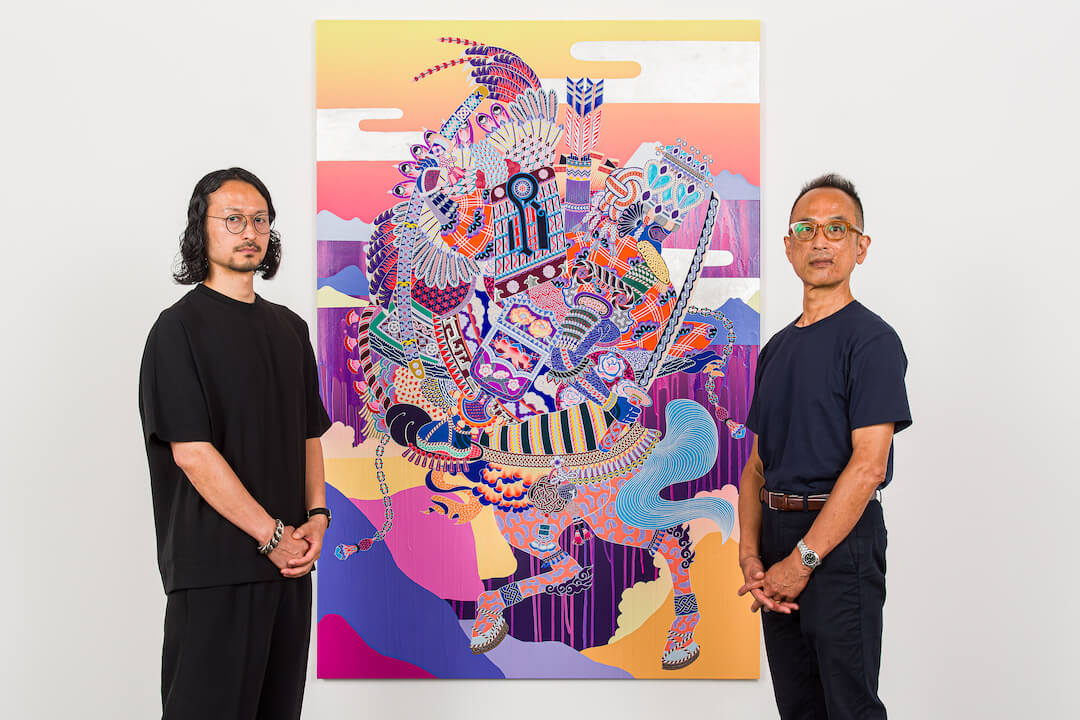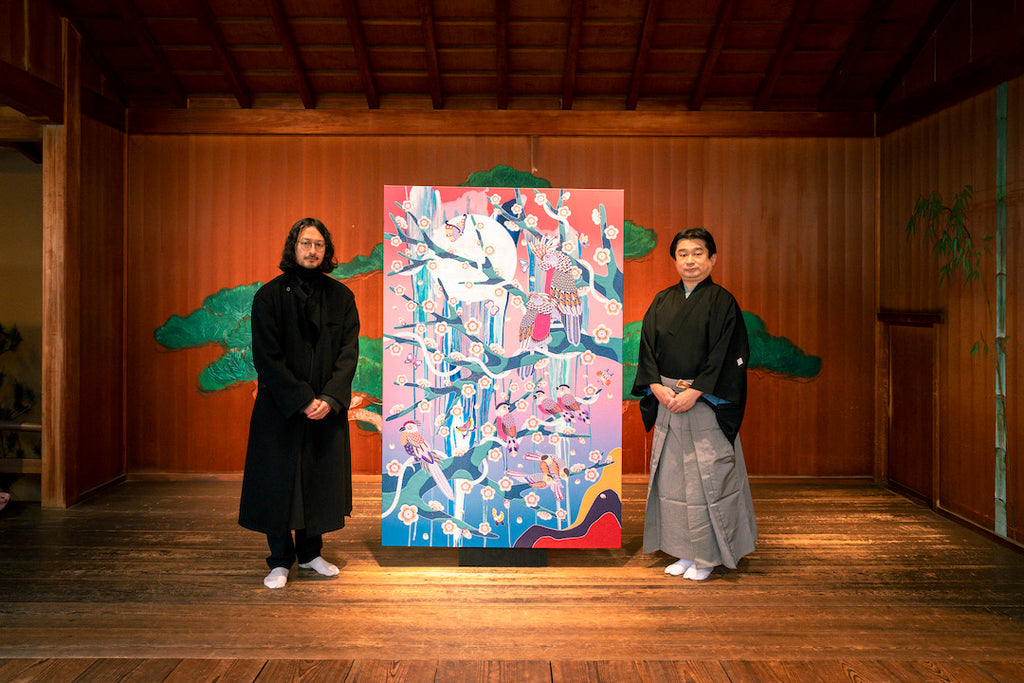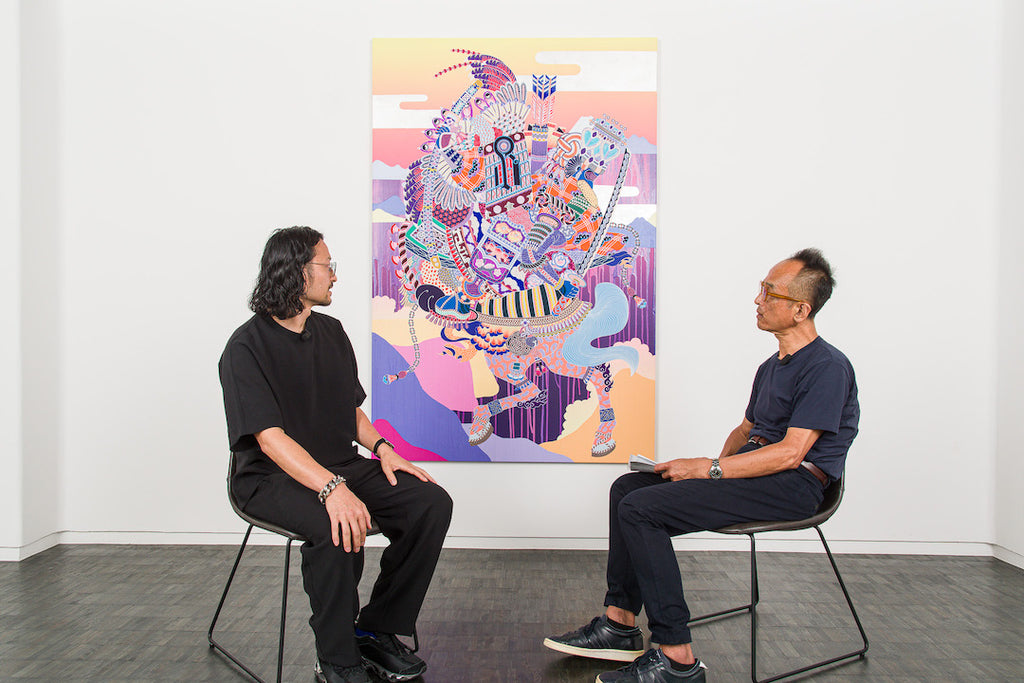ARTICLES
Kohei Kyomori × Meiji Hijikata | The Intersection of Design, Art, and Decoration
2023.09.20
INTERVIEW

Kohei Kyomori and Meiji Hijikata
This series of articles features conversations between various artists and Meiji Hijikata, Director of the Taro Okamoto Museum of Art, Kawasaki, to take a deeper look into their artworks. The second installment is a conversation with Kohei Kyomori, a decorative artist who seeks to create a unique visual language by reinterpreting decorations from all ages and cultures through a contemporary perspective.
This is the first part of a two-part article, focusing on the discussion between the two about Kyomori's transition into the realm of fine art following his career in fashion and his adoption of decoration as a central motif in his art. The conversation transcends time, initially delving into the intricate relationship between design and art and then progressing to the historical origins of decoration, which has become the core theme of Kyomori's artistic endeavors.
Finding the Boundary Between Design and Fine Art

Kohei Kyomori in front of his painting "R.E.P. Portrait Michael" (2021, 91.0 × 91.0 × 2.0 cm, acrylic paint on canvas).
Hijikata: Your career did not begin in fine art, but you were active in the world of graphics, illustrations, and fashion. What made you decide to change course to fine art from this world that lies parallel to art?
Kyomori: Initially, my move to Tokyo was driven by the desire to pursue a career in graphic design. However, I found myself captivated by Tokyo's vibrant fashion scene, leading me to enroll in a fashion school. While studying, I had the incredible opportunity to spend two years studying abroad in Milan, Italy. Upon my return to Japan, I became an apprentice to an art director who was also involved in contemporary art. This experience provided me with an intimate understanding of art and the creative process, gradually igniting my own interest in artistic expression.
Hijikata: Even though your interests had moved from fashion to art, I think it would have been difficult for you to be able to create artworks straight away. Was there something that served as a trigger?
Kyomori: There was nothing in particular. But when I was starting on my own as a graphic designer, I always had a desire to create artistic expressions, and I had this vague idea that anything can become art if I just keep doing it.
Hijikata: What kind of work did you usually do back then?
Kyomori: As a graphic designer, I've always had the concept of "decoration" in my mind, even during my early years in the field while creating designs for advertisements, catalogs, and more. There was a phase when I would methodically draw circles and embellish them with a plethora of decorations. It was only several years after venturing into independence that I made the conscious choice to transition into the role of an artist in my own right. This marked the beginning of my journey into submitting my artwork to various art competitions.
Hijikata: You were steadily exploring your approach into the world of art?
Kyomori: During that time, I was still working on designs for advertisements, so my priority was to meet the expectations of my clients. But my desire for artistic expression was overflowing, and I felt that if I did not create an output for the things I wanted to express, I would no longer be able to continue pursuing it.
Hijikata: Tadanori Yokoo said something similar when I talked to him some time ago. Even though he was a very successful graphic designer and illustrator, the work he did had a strong aspect of being made-to-order, so he could not easily do the things he truly wanted to do. Design work and fine art are very closely related, but there is a tacit understanding that the two are separated by a boundary. On the other hand, when asked about the difference between design and fine art, very few people can probably give a clear-cut answer. I think this boundary is becoming even more blurred for your generation. What do you think?
Kyomori: I have always liked Yokoo's artworks. Personally, I think that advertising design was even closer to art during Yokoo's generation, whereas in my generation, consulting and design have formed a close relationship. Creating a painting is no longer considered design work. In this age, the creative process for art and design are quite distinct from each other, so back then, I felt that the things I wanted to express were meant for an entirely different field.

Kohei Kyomori creating a painting
Hijikata: When did you start creating artworks that specifically involved decoration?
Kyomori: I started making them around 10 years ago, and the first time I exhibited them was about 6 years ago. It was during a time when I was doing only graphic works for clients, and I really wanted to express myself artistically, but I still had no idea how to do it. Then I figured that I might be able to start something if I joined an art competition. The very first competition I joined was one that allowed me to present my work at the Spiral arts complex in Tokyo.
Hijikata: What kind of response did you receive at that time?
Kyomori: My work at that time was a painting of a flower on a wooden board, and it was not as extravagant in terms of decoration compared to what I make these days. Looking back, I think it was just my first small step outside of the domain of design.
Hijikata: After that, did you gradually become more conscious of turning decorations into works of art?
Kyomori: My initial artwork was created during my tenure as a graphic designer, with the notion of it potentially becoming part of someone's collection lingering in the back of my mind. However, I eventually made the deliberate choice to dedicate myself to expressing the ideas and emotions that emanated from my heart. I embarked on crafting artworks that are in alignment with my current artistic style. It was during this phase that I began to receive high praise for my work, encouraging me to continue creating paintings featuring various ornamental elements in a similar style.
Discovering the Heart of Kyomori's Ornamental Fascination

Kohei Kyomori "M Nobu col.1" (2023, 94.0 × 130.0 × 3.0 cm, resin/mineral pigment/mixed media on canvas)
Hijikata: You've previously mentioned that the concept of "decoration" or "ornamentation" was ingrained in your mind from an early stage. Considering your experiences abroad, could you elaborate on your particular interpretation or concept of "decoration"?
Kyomori: Even before the idea of decoration, I have always been fascinated with densely intricate things and assemblages of various objects. I think it was something that I simply liked. When I was in Europe, I often looked at things like religious architecture and stained glass windows. I found decorations in all sorts of objects in Europe, and I just kept taking pictures of them with my camera.
Hijikata: Are you referring to something akin to the intricate Arabesque patterns often seen in Islamic architecture?
Kyomori: Yes. There was a time during my 20s when I often made drawings of patterns of meandering lines, though they were not something I intended to show to others. It's probably because my inner self desires such arrangements of densely intricate objects.
Hijikata: Given your innate fascination with intricate objects, how did you come to associate it with decoration?
Kyomori: After seeing countless ornaments and decorations in Europe, I realized that I liked the word "decoration". I made it my own internal keyword, and I thought that the works I exhibit should express decorations or something closely related to decoration. Sometime after getting engaged in art, I thought about why I became fascinated with decorations, and it came to my mind that throughout history, decorations have been deftly adopted by religions, royalty, and other authority figures.
Hijikata: In a way, the roots of decoration are intertwined with the origins of art itself. Consider, for instance, the rope pattern impressions found in ancient Jomon pottery in Japan, which are believed to hold a mystical significance beyond their decorative function. Similarly, in ancient Western cultures, you'll often find swirl patterns on wall paintings, amulets, and talismans. Over time, I believe these mystical elements in the patterns became rationalized, gradually transforming into decorations that people could seamlessly integrate into their everyday lives. This is why decorations will forever remain an integral part of human existence and culture.
Decorative Expressions of the Era and Country

Meiji Hijikata in front of Kohei Kyomori's "Flowing A-UN women & men col.2" (2023, 91.5 × 73.0 × 5.0 cm, resin/mineral pigment/mixed media on canvas).
Hijikata: When I observe your paintings, it seems like you aim to integrate decorative elements from diverse countries and cultures. When did you begin to view decoration as something that transcends any specific time or place?
Kyomori: It's not a conscious effort on my part. Instead, I believe it's an outcome of how I blend the materials I've collected over the course of my life. Personally, the historical or functional significance of each decoration I incorporate doesn't hold particular importance. When I integrate decorations into an artwork, I focus on their arrangement, visualization, and transformation into a fresh form of decoration.
Hijikata: Do you have any particular preferences? For instance, do you find yourself drawn to the decorations of a specific country or culture?
Kyomori: I don't hold any specific preferences. What matters to me is the intricacy and the amalgamation of these decorations. I believe that designs and techniques developed over an extended period are the ones that are truly captivating.
Hijikata: I believe that's your strength. You have the ability to assimilate various designs from different countries into your extensive repertoire. In a way, you're not constrained by the typical constraints of fine art. Often, when people acquire knowledge about the history of art or decorative design, regardless of how much or how little, they tend to create internal hierarchies. This can impede their ability to diversify their repertoire. However, in your case, you trust your instincts and seamlessly blend various decorations into a single, bold image. I think individuals deeply entrenched in the world of fine art throughout their lives may struggle to cultivate such sensibilities.

The pair talk about the nature of decoration while looking at Kyomori's "M_Nobu_col1".
For Kyomori, decorations not only serve as the central theme of his artworks but also hold a special place in his heart. Throughout history, decorations have often been employed as symbols of divinity or authority, leaving a profound impact on culture and society. However, Kyomori approaches them with a fresh perspective, seamlessly integrating them into his art. His dialogue with Hijikata has yielded novel insights at the crossroads of design, art, and decoration. In the latter part of the article, they delve into Kyomori's creative process and provide a glimpse into his upcoming exhibition in Beijing, China.



